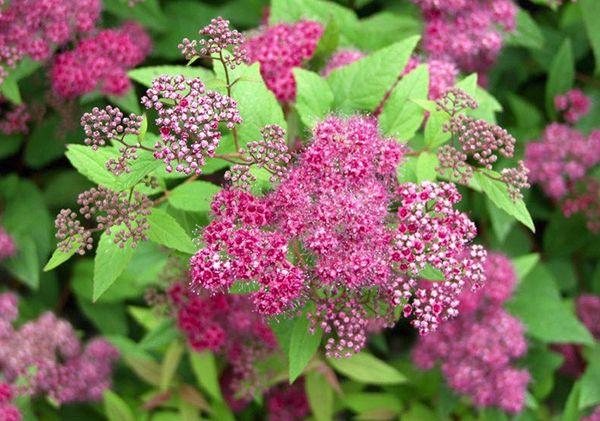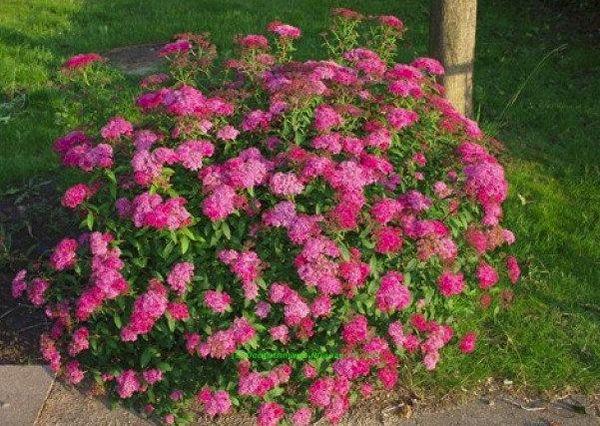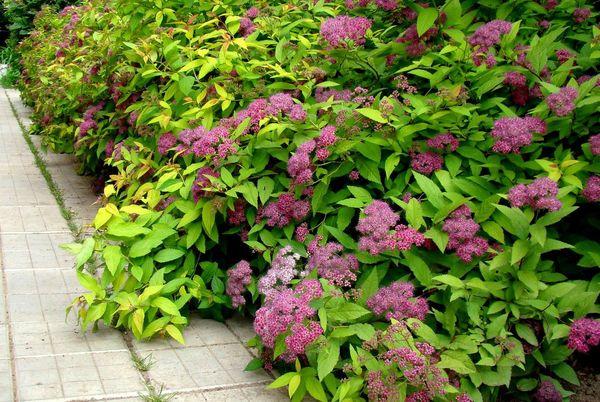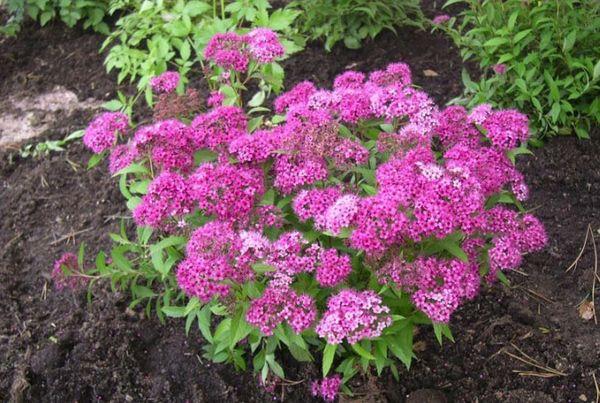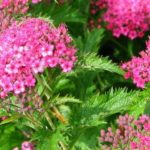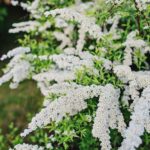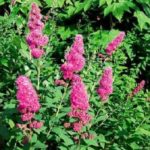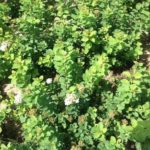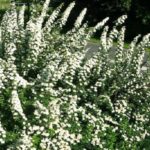The beautiful flowering shrub of Japanese Frobeli spirea often attracts attention in city parks and squares. But gardeners especially loved the flower as an original decoration for the local area. There are more than 100 species in the genus, distributed in the northern hemispheres of the planet. Asian breeders developed the Japanese Frobeli spirea species. Until now, southwestern China is considered the center for the conservation and development of the species Spiraea japonica.
General information about Spiraea Japanese Frobeli
Froebelii is a low shrub, growing from 0.7 to 1.2 m in diameter and the same in height. The crown is spherical, erect branches. It has the peculiarity of all types of spirea to change the color of the foliage during the season: green in summer, purple-red when the seasons change.
Japanese spirea blooms from late July to September. Abundant flowering immediately attracts the eye. Pink inflorescences up to 12 cm in diameter are formed in dense corymbose inflorescences.
Positive and negative aspects of the variety
Japanese spirea is a summer species, therefore it blooms and smells fragrant in the warm season. The bright, rich color of the bush attracts attention from afar. If planted as a separate growing bush, it will stand out as a bright spot against the background of the garden.
In spring and late autumn, only branches are visible; they do not shine with much beauty. Mature shrubs fill the space well and keep weeds out. They do not require complex care, but regular watering and nutrition allow the flower caps of Japanese spirea to be larger.
Features of cultivation
It is necessary to allocate a place for the seedling, taking into account the adult state of the bush. The first year you can plant ground cover plants nearby. In the future, Japanese spirea will grow, occupying a diameter of 1.2 m. The plantings should not be thickened, the shrub will develop poorly. The annual growth is 10-12 cm in height.
The shrub grows in partial shade; conifers are excellent neighbors: thuja, junipers, as well as contrasting hostas and heucheras. In a gardening store you can buy planting material: seeds, roots, cuttings. The first method is difficult and time-consuming. The second will allow you to get spirea flowering in the second year of planting.
Place and time
For spirea, choose a sunny or partial shade location.If it is a hedge, then the shrubs are planted along the planned location at a distance of 0.7-1.2 m from each other. When planting Japanese spirea in a permanent place in a flower garden, take into account the height of neighboring plants, as well as the color of neighboring shrubs. Contrasting or one color at the gardener’s choice.
Summer-flowering spirea Frobeli is planted in the spring until mid-May. In the fall, until September 5-10, the shrub takes root well on cool days. A place is chosen in advance. The soil is prepared by carefully selecting weeds, otherwise the young seedlings will be crushed by aggressive weeds. The soil should be slightly acidic or neutral.
Planting a plant
A cloudy but not rainy day is an excellent time to plant Japanese Frobeli spirea. For long-term flowering in one place, it is necessary to prepare the soil:
- If possible, make drainage, lay a layer of large expanded clay and broken bricks in a ditch 50-70 cm deep.
- Mix the soil with peat and leaf mixture.
- Add fertilizers; spring fertilizers or complex ones for flowering shrubs are suitable.
- After planting, cover 2-3 cm with sawdust, this will prevent weeds from sprouting.
- The hole for one bush should be 3 times larger than the root system. Prepare 3-4 days in advance, then drain and water well.
The treated planting material is planted to a depth of 0.4 meters; the root collar is not buried. The cutting is placed in a hole and covered with earth, compacted well. The cuttings must be washed, dried a little, and the roots separated. Be sure to treat it for fungal diseases and send it to a new place.
Further care of the bush
Regular watering, fertilizing and pruning faded buds is all that is required for good development.During the growing season, the bush needs to be regularly inspected; diseases or pests may develop; this can be combated with proper agricultural technology.
Watering rules
Spiraea is unpretentious, the plant regulates its water balance independently. During drought, it is necessary to water with warm, settled water. 10-15 liters will be enough early in the morning or after 18:00.
It is recommended to water under the bush so that water does not fall on the flowers. Green branches can be perfectly moistened during rain.
Fertilizer application
Watering is combined with the application of fertilizers. In the spring, when planting or digging, preference is given to complex fertilizing with a predominance of nitrogen. This will make it possible to increase the green mass and prepare for abundant flowering.
In the summer months, potassium-phosphorus mixtures are added. Every 3 weeks with watering the bush. For vigorous flowering, simple phosphorus is added. You need to apply dry fertilizers directly into the soil, cover them with a rake and water them abundantly.
Spraying with stimulating and anti-stress drugs is possible in spring and summer. Microfertilizers allow you to survive early spring frosts and summer heat. During the season, 3 sprayings with Epin, Zircon and other products with similar properties are recommended.
Even with a balanced diet, the flowering of spirea cannot be prolonged, but the flowers will look luxurious throughout the entire period.
Trimming
To form beautiful bushes you need pruning Japanese spirea Frobeli. They begin to form the plant immediately after the branches grow 30 cm. The owner chooses the shape according to the style of the landscape; it can be spherical or pyramidal. Do not choose a square one, even if it is a hedge.
During the summer, hygienic pruning is carried out, faded buds and withered branches are removed. This way, new buds grow faster, and the bush will always be in bloom.
Pests
Pests love fragrant and juicy spirea. It is necessary to fight them as soon as you see that something is wrong with the bush.
Spider mites attack in the first warm days. The plant is shrouded in cobwebs, the leaves look dull. Spraying with special solutions is suitable. “Karbofos” works well, dilute strictly according to the attached instructions, spray in cloudy weather.
In hot weather, aphids attack. Sucks juice from leaves and stems of plants. The leaves curl, if you do not fight the pest, by autumn the crop will be weakened and may not survive the winter. It is especially bad when branches are affected. It is necessary to fight aphids; all biological and chemical means can be used.
Spiraea diseases
Various types of spotting can affect: phyllostictosis, cercospora, ascochyta. They affect the foliage with unsightly spots, starting from the edge of the leaf, then covering the entire leaf. Treatment: correct agricultural technology, processing of planting material, removal of the first diseased leaves.
Culture propagation
Three methods of propagating spirea allow you to choose the most convenient one in the conditions of a particular region.
The right choice will allow you to grow a healthy large plant:
- Dividing the bush is best done in early spring. The grown, stronger branches are dug up and transplanted to a new place. With this method, spirea grows actively. Before transplanting, treat the roots with an anti-disease agent.
- It is better to start cutting branches in the fall. Harvested cuttings of 12-15 cm are treated with fungicidal solutions and placed on nutrient soil.This must be done in a cool room. The box is covered with black film and left until the first buds appear.
- Reproduction by layering is the most effective method. The branches of an adult healthy seedling are bent to the ground and sprinkled. Over the summer, it takes root from a new plant, then planted in a permanent place.
It is also recommended to germinate spirea seeds at home in cool conditions. Create greenhouse conditions for young shoots in early spring, and they will develop healthy throughout the growing season. In well-established warm weather, plant outside.
Application in landscape design
Spiraea is a summer-flowering species. The shrub is excellent for hedges in garden areas. Long flowering allows it to be planted along pedestrian paths and recreation areas. Looks great along the fence, forming an endlessly blooming path.
Used when creating flower beds. Select nearby plants according to their flowering dates, and the flower garden will bloom beautifully all summer, and the main role will be played by Japanese spirea Frobeli.
You can create a mixborder not only from Frobeli spirea, but also use other similar ones. Many colors will allow you to create a whole sea of flowers. If you need to improve a place with trees on your site, then you won’t find anything better than Japanese Spiraea Frobeli. It looks decorative under tall pines; designers often make the transition to shorter flowers with the help of beautiful flowering shrubs.

